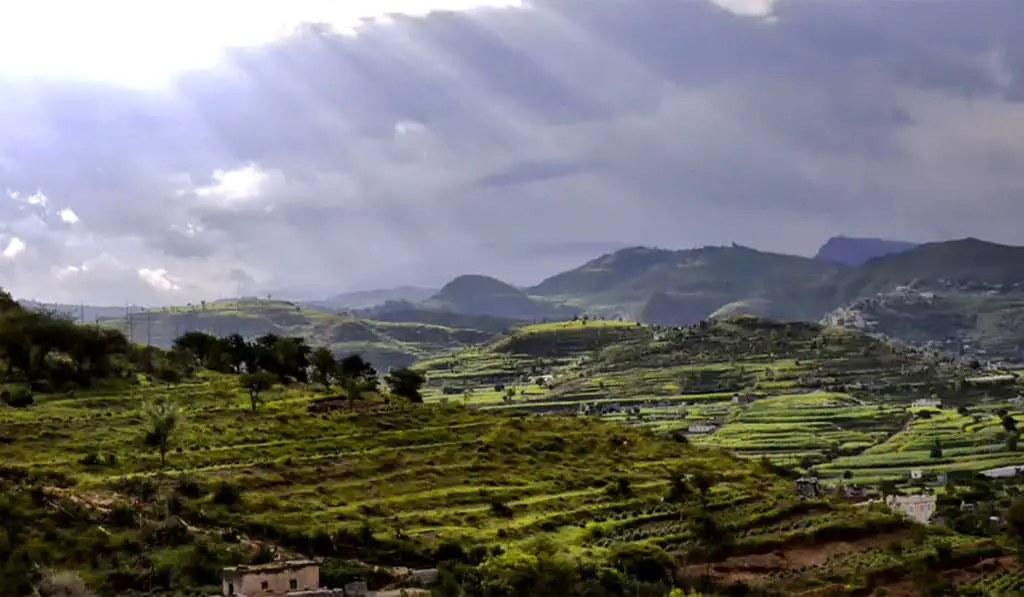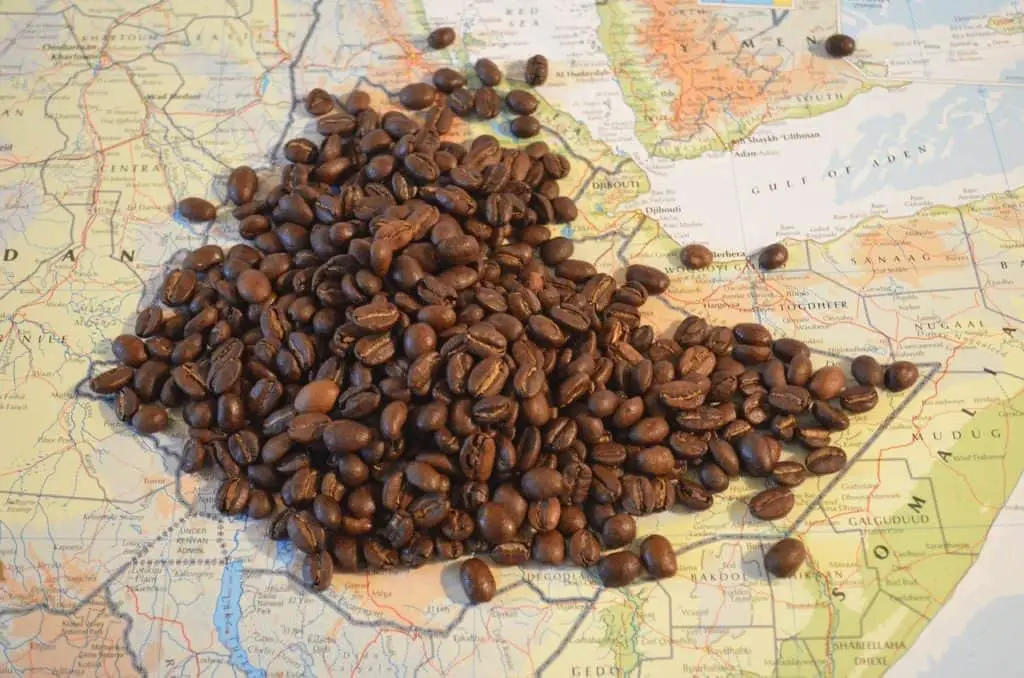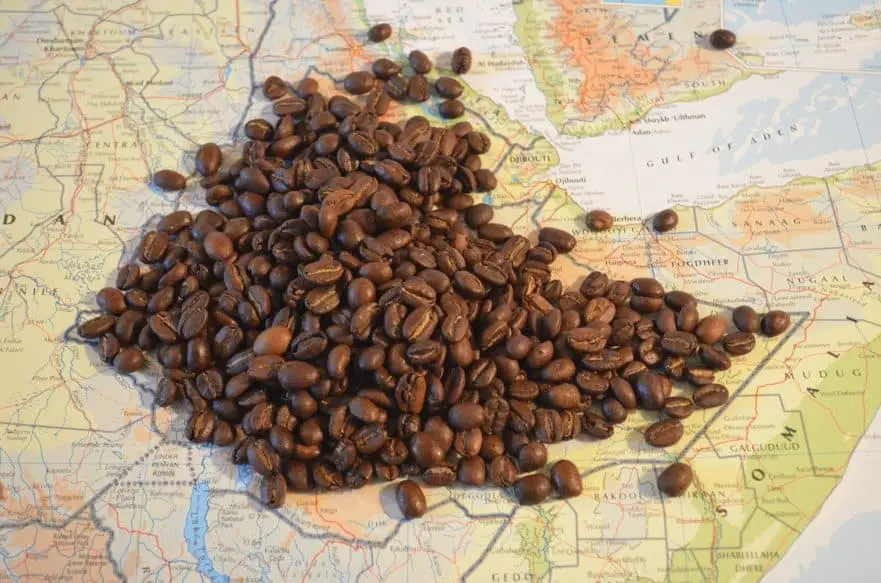
Yemen natural processed coffee is expensive due to its distinctive flavor, the small amount of hand picked coffee harvested from local coffee farms, lack of modern infrastructure and the cost of transportation from farm to port.
Some 90% of all of the coffee in the world can be traced to right back to Yemen. As a matter of fact, the word coffee comes from the Arabic word Qahwa. This hardly comes as a surprise given the immense proliferation of what are known as the legendary Arabica beans.
Yemen has played an all important role in the overall popularity of the coffee that so many people drink today on a regular basis. From there, it was introduced to many different parts of the world, in a relatively short period of time, still maintaining its unique and special characteristics.
Harvesting Yemen Coffee
To begin with, you need to understand that its practices of cultivation have remained largely unchanged for more than 500 years. This is possible because of the types of farms that are ran, mainly small family terraced fields that are beautifully carved into the landscape, in ways that are similar to tea growing farms farther east.
These small operations have made it easier to avoid the use of chemicals. Also, this means that when each fruit is ripe that they are hand-picked, thereby ensuring real quality control is observed.
A more hands on approach also implies that the beans aren’t removed from the fruit in which they grow before they are set out to dry, as many industrial operations count on. They are dry-processed together in special drying periods that take place primarily in caverns. Yet, some families make use of rooftops.
What you get when the fruit is dried are considerably irregular and rough seeds. This is what characterize Yemeni coffee and provide it with a savory yet robust aroma. Then, the time comes for the millstones to grind them, which are turned by either donkeys or camels.
A big reason why these beans have such a reverence around the world is that only the most flavorful and aged beans are exported outside the country. This is due to considerable diligence and close attention to each part of the production process that is wonderfully free of industrial mechanizations.
Where in the Middle East is Yemen?
Yemen lies south of the Arabian Peninsula between Oman and Saudi Arabia right at the entrance to the Bab-el-Mandeb Strait which links the massive Indian Ocean with the very trade important Red Sea. It has a mountainous interior that in various ways resembles other coffee growing hotspots like Colombia where coffee can be grown all along the sides.
These altitudes are the biggest key factors in yielding quality coffee that has the most delicious and elaborate flavors. When you combine these heights with drought-prone land, what you get are an ancient coffee variety that’s special and distinct.
In fact, such a rugged landscape means that, although the quality of the coffee beans that come from here are high, the yield rate is actually rather low, particularly when you stop to compare it to other coffee varieties that have gained attention in the market, especially those that are being produced in the Western Hemisphere.
Where in Yemen is its best coffee grown?
Many have pointed to its slow production in such a trying landscape as a big factor in why its demand internationally is exceptionally high as well as savory when compared to those that come from more moderate climates.
Just how high up are we talking? The best conditions are achieved at altitudes around 2,400 meters over the sea which fortunately for the coffee plant includes the vast majority of the country’s territory, which in turn results in coffee being cultivated in a whopping 4/5th’s of regions!
The biggest coffee producing regions in the north are Al Mahweet, Sanaa, Hajjah, Sa’dah, Sanaa, Hajjah and Sa’dah. Just as important for coffee cultivation are the west regions of Yamah and Al Hodaldah, and if you do love to compare it pays to pay attention to the variability that’s available in altitudes.
How Coffee in Yemen Became A Beverage
Most experts agree that coffee began in western Ethiopia. Here, nomadic tribes are thought to have been the first to discover its unique stimulating effects. Eventually, the Ottoman Empire turned it into a beverage of sorts in the 6th century leaving the first archeological evidence of coffee beverage consumption in the Yemeni city of Zabid.
Reliable evidence points to coffee consumption and knowledge about this important tree to Sufi monasteries around 1450. It was directed towards meeting the needs of the locals. Monks themselves began to drink coffee for the purpose of staying awake during long bouts of nighttime prayer.
It wouldn’t be too long before this practice would spread all around the Arabian Peninsula and reach the many opportunities that were present around the Red Sea.
Yemeni culture is tied to the coffee tree. This makes a lot of sense when you take into account how long it’s very involved processing actually takes from start to finish. Only surpassed in popularity by water, this beverage, which was cultivated and developed into the kinds of beans that you can pick up at the store, is believed to originate in Yemen.
Yemen’s Role in the Coffee Market

Yemenis were the first to harvest coffee and, as such, were in a unique position to capitalize on its enormous commercial potential. In the 1500’s this coffee was already being exported to Turkey, Persia and Egypt.
In many ways, it put Yemen on the map, so to speak. It provided this largely arid nation with a wonderfully large source of revenue and the very advantageous position of being the only source of coffee for a glorious 200 years.
Exportation exploded around this time. As a consequence, more and more trade routes were established and carried out by camels who would traverse Yemen’s highlands. This booming industry was born!
A real turning point was its inclusion in the mercantile systems that were being developed with respect to the Red Sea. This was the key to reaching all manner of huge markets, including India and Turkey.
Yemen Coffee Profiles
A big reason why this coffee is so beloved is that its flavor is actually quite complex and very distinct in both flavor and aroma. Most would start by pointing out its earthiness that dances with more fruity, although dry, aspects. It really does taste like the ideal coffee to drink on cold nights as its notes of cinnamon, chocolate, cardamom and, sometimes, even tobacco make it soothing and a real treat to enjoy.
Many regard it as a wild variety. It commonly tastes full-bodied highlighting its rich tones. They are accented by a special acidity that for many people reminds them of wine, particularly the kind that’s produced in mountainous places like Chile.
Some of the finest Yemeni coffees are called Matari as they are grown in the city of Bani Mattar, west of the capital city of Sanaa. It has gained a lot of acclaim for featuring very strong tones of both wine and chocolate. At the same time, it is more acidic than your average Yemeni coffee. This makes it a popular choice among coffee drinkers that like a strong taste in their cup.
In contrast, Ismaili coffee is grown in the center of the country and is also the name of a specific type of coffee plant. This plant is distinguished by being smaller and being gentler to the taste buds, In part because of its malty flavor notes.
Magnificent Mocha Beans from Yemen
A point of pride are the Mocha beans which are most likely the most well known around the world. Their name comes from the famous Yemeni port that looks out onto the Red Sea and established itself as real coffee for the early days of the coffee trade.
It was when men Yemenis were looking for newer and farther markets out east. It is because of this drive that the port came to be known as a real point of origin and its name became attached to the shipping of these precious beans.
Coffee beans that come from Mocha are well known for their high quality. Also, they feature a chocolate taste that’s considered a true luxury. This is reflected in its pricing which is around two to four times the price of other specialty coffees that you’ll find at the store.
Cherries That Spread Across The World
The two main varieties of coffee cherries that have gone on to be grown in many places far beyond Yemeni borders are Typical and Bourbon.
Bourbon beans’ genetic base originates from coffee plants that are found around the city of Mokha. These are especially deep in their buttery chocolatiness and are very beloved by sweet lovers who enjoy treating their tongues to fruit overtones.
Typica beans are thought to have originated in southwestern Ethiopia. Around the 15th century, they were taken to Yemen where they were developed to have a clean and resonant acidity that provided it with floral and lemon notes. These tones lead one to enjoy a sweet aftertaste. It is considered to be of excellent quality and was first exported to India for cultivation.
In many coffee shops today, mocha drinks refer to coffee that has sugary chocolate added to it. This particular type of presentation emerged around the end of the 19th century. While it was inspired by mocha beans, it more often than not isn’t true mocha coffee.
The next time youre shopping around, you may want to do plenty of research so that you may land on a brew that really does speak to what your preferences are when it comes to tasting great coffee.
A Changing Coffee world
It’s of the utmost importance that this sector of its economy be propelled forward again to ensure the bright future that Yemen deserves, especially after experiencing so much political turmoil.
Today, it is competing with beans that are grown in other parts of the world that offer similarly favorable conditions to achieve delicious flavors. Yet, in a blind test, Yemeni coffee will always remain on top.
Those that like to really experience a landscape through a coffee that is as nuanced and sensationally engrossing as a lovely glass of wine are sure to keep seeking out delicious roasts. Specially it´s interesting to follow those reflecting the rich history that is backed by a loving devotion that a whole nation is able to produce.
Without expecting it, the entire landscape of beverages has changed considerably for the better in terms of selection. However, there are many who still hold Yemeni coffee in the highest regard and without equal.
When you take the time to appreciate the complexity in flavors that have been lovingly cultivated through the years, some of which include berries, dried figs, stone fruits, among others, you can genuinely admire the gem that a dry and rocky landscape can deliver to the pleasure of a coffee drinking society.

